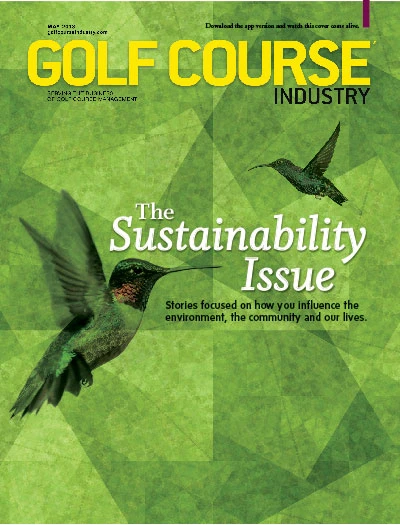 Imagine walking out to play a round of golf. You take your first swing…and your ball lands in the pine straw mulch. As you walk through it and try not to slip, you wonder to yourself why anyone would landscape with something that could be such a hazard to golfers.
Imagine walking out to play a round of golf. You take your first swing…and your ball lands in the pine straw mulch. As you walk through it and try not to slip, you wonder to yourself why anyone would landscape with something that could be such a hazard to golfers.
The Club at Mediterra in Naples, Fla. has the solution. Frank Heery, the director of agronomy, has helped implement a program at the club that eliminates the need for pine straw mulch on the course. The best part? The program also has a large, positive environmental impact.
Pine straw is expensive, especially since it only has a six month residual. With Mediterra being about 40 acres, Heery guesses they were putting down upwards of $200,000 a year.
“[I said] there’s got to be a way to cut this cost,” Heery says.
Mediterra is located near a housing community that is associated with 1,800 acres of wild growth. Because of this, a lot of pruning is required to keep the area maintained. The material from that (about 10 yards worth) was then hauled off-site.
One day, a man by the name of Robert Oleski stopped by the course. He had just started a new company, called Green Club Recycling. According to their website, the company “offers on-site horticulture shredding which may be used for landscape mulch or compost material.” Oleski showed Heery a sample of the shredded product.
“It looks identical to pine straw,” Heery says. “It would be safer for the golfer, and from a shot standpoint it works out better because it holds the ball up a little bit better.”
It’s also less expensive. Mediterra has eliminated the cost of purchasing pine straw, and the previous cost of hauling the unused material off-site is roughly the same as the current cost to shred it. “We’re saving $100,000 a year,” Heery says.
Mediterra has taken it a step further, now doing the same with a soil shredder. Any material that is grass based and has soil, such as material from the beds, sodwork and grass clipping, are put into a bin and then shredded down to become composted soil. This summer they will use a manure spreader to topdress the rough.
 “It should save us some fertilizer applications,” Heery says. “We’re fortifying the soil with composted material.”
“It should save us some fertilizer applications,” Heery says. “We’re fortifying the soil with composted material.”
One problem Mediterra has run into so far is keeping the shredded material stockpiled. The material is kept in a 30-yard bin and Heery calls the company when the bin is full. Depending on thickness, the shredded material can cover half to a full acre. Heery is hopeful that there will be a way to convince the community association landscapers to dump their material in the course’s bin as well.
“You would be making a tremendous environmental impact because you’d be saving everything that comes off of the grounds and recycling it,” he says.
Another problem is that currently, the course still needs to spray herbicides. Heery says they have a couple of ideas of how to fix that, but for now they still send guys around with sprayers.
“The next phase is to say, ‘Alright, how do you get even more environmental and not have to get out and spray weeds,” Heery says.
Katie Tuttle is GCI’s assistant editor.

Explore the May 2013 Issue
Check out more from this issue and find your next story to read.
Latest from Golf Course Industry
- LOKSAND opens North American office
- Standard Golf announces new product lineup for 2025
- The Salt Pond taps Troon for management
- KemperSports selected to manage Swansea Country Club
- From the publisher’s pen: Grab that guide
- Introducing our April 2025 issue
- South Carolina leaders honor golf course superintendent
- One and only





